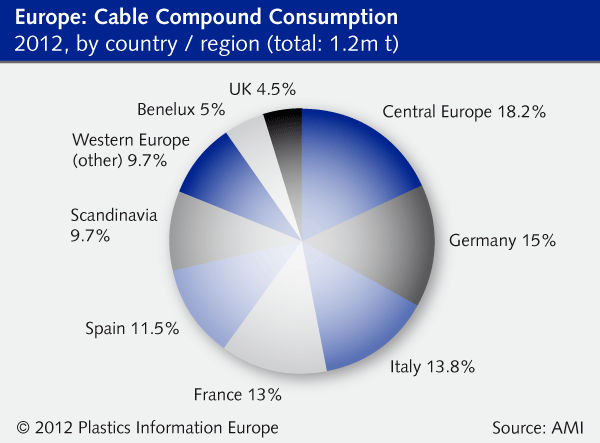EUROPEAN CABLE INDUSTRY
Production accounts for 4% of value of resin output / Consolidation continues / PVC remains dominant material / Germany leads demand / AMI report
 | |
Consumption of compounds by the European cable industry in 2012 will total 1.23m t, according to a recent report – “The cable industry in Europe” from plastics industry consultant Applied Market Information (AMI, Bristol / UK; www.amiplastics.com) and, despite the impact of the global financial and Eurozone crises, production of cable appears to be steady. The cable extrusion industry accounts for 4% of the value of resin produced in Europe, however, it consumes only 2% of output.
Over the past three years, there has been consolidation in the industry as producers expand global reach and achieve benefits of scale. Many companies have refocused their portfolios with the manufacture of particular cables for specific markets, often driven by local demand, the researcher said. The AMI report includes data on 325 production sites in 2012, compared with 340 in 2008.
Technology in the industry is constantly developing through innovation in the formulation and modification of resins and the development of additives, particularly for flame retardant applications and the use of LSF0H (low smoke and fume, zero halogen) polymers. PVC remains the leading polymer material used in cable production in Europe and the world, with 87% of European extrusion sites processing the material at their plant. However, its use has fallen steadily by around 2-3 % annually over the past decade and this trend is forecast to continue for the foreseeable future as competing, finished PVC product is imported to western Europe from Russia, central Europe and China.
Demand for conventional LDPE and cellular PE in cable production has declined, while the use of linear grades of PE and LSF0H has grown rapidly, although volumes remain small. Other PE materials have seen steady growth, while demand for high or medium-density PE has been lower. This has led to use of PE growing at between 1% and 2% annually for the past decade.
PP has experienced good growth in cable applications in Europe in recent years, although the market is very small, with its application limited mainly to use in fibre optic cables.
Germany and Italy lead European demand with 15% and 14% respectively, followed by France (13%) and Spain (11.5%). Poland now accounts for over 10% of polymer demand for cable production and, despite having only half the number of manufacturing sites as Spain, matches the annual consumption of polymer used in production.
For more information, see “AMI's Guide to the Cable Industry in Europe", 6th edition, AMI 2012, Details: www.amiplastics.com
Contact: Regine Futter, Tel: +44 117 9249-442, email: rfutter@amiplastics.com
18.07.2012 Plasteurope.com [222871-0]
Published on 18.07.2012

 German version of this article...
German version of this article...